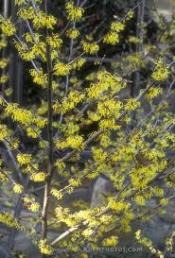Tag Archives: SEATTLE GARDEN DESIGN
The Art of Garden Lighting: Enhancing Your Landscape’s Beauty After Dark
By Teri Silver for Seattle Landscape Architect Brooks Kolb
Garden and landscape lighting gives your Seattle home a sensual after-dark glow, enhancing the overall beauty of the property. Lighting up the garden and landscaping is more than placing a fixture here and there. Before heading to the home improvement store, plan your project by first deciding on what your objectives are.
Do you want a tranquil setting for evening relaxation? How about ambient lighting near pathways and seating areas? Maybe a party atmosphere? Aesthetics aside, landscape lighting increases home security and pedestrian safety.
Low Voltage Lighting
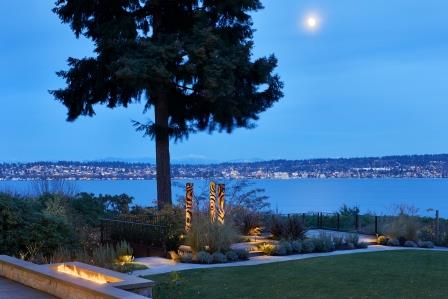
Windermere Garden – Seattle Landscape Architect Brooks Kolb/photo by Ben Benschneider
Most landscape lighting installed today is low voltage. Unlike standard 120-volt systems that run inside the house, low voltage LED systems are safer to use outdoors and use considerably less power. Low voltage systems bring the ambience of lighting that mimics anything from soft moonlight to stronger glows for your garden and deck or patio space.
Landscape Lighting
In whatever ways you want to bring the landscape design to life, lighting is divided into three categories: uplighting, downlighting, and pathway lighting.
Uplighting comes from fixtures placed directly on the ground and pointing upward. Set ground lights next to trees, flagpoles, and statues to bring the object into view and create dramatic accents of light and shadow. Trees with umbrella canopies like Japanese Maples and multi-trunk trees like Crape Myrtle are particularly graceful to uplight.
Downlighting casts diffused light from atop a structure, like a pole, pergola, or building wall.
Pathway lighting brightens up steps and paths, providing safety for your walk to and from the house and around the garden.
Think of uplighting as being primarily about accenting and creating beauty, downlighting as providing light for outdoor dining or socializing, and pathway lighting as providing safety.
Here are some classic ways to enhance the outside of your Seattle home with perimeter and landscape lighting.
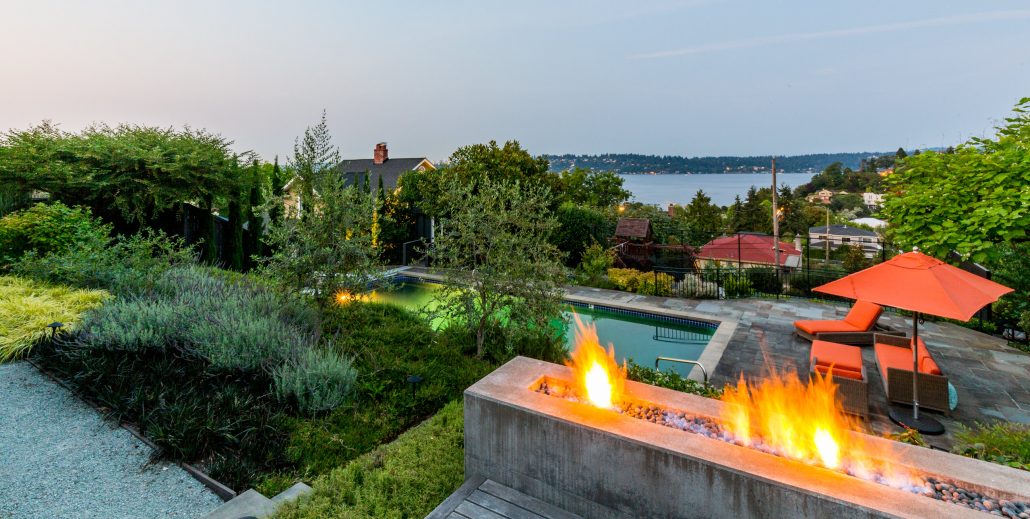
Mount Baker Garden – Seattle Landscape Architect Brooks Kolb/photo by Miranda Estes
Welcome Home!
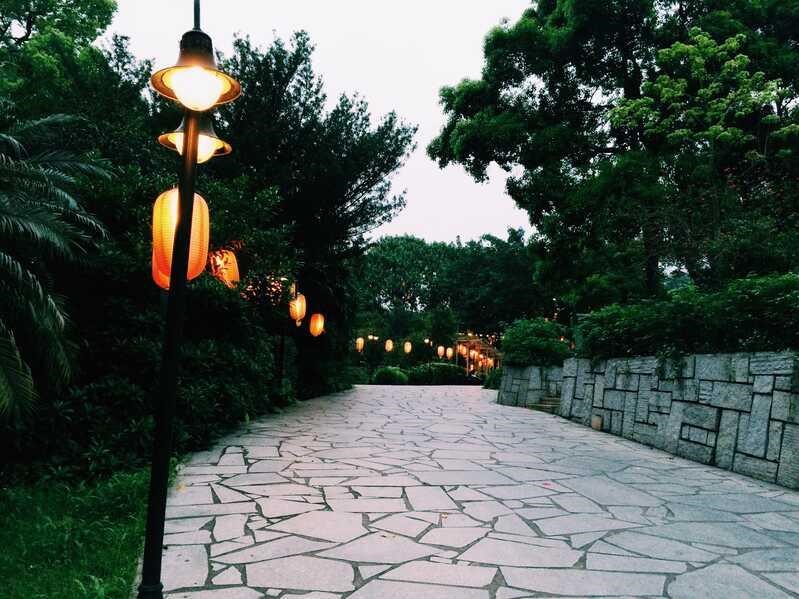
The first thing people see when they look at your Seattle house is the front yard, garage, and front door.
At twilight or nighttime, the front garden benefits from a few bright spots, especially up pathways to the front door. Wall wash lighting brings an indirect, angled glow to the object of a flat surface.
Wall grazing — where the light shines upward — highlights rough textures like paving bricks and stucco. The accents made by double sconce lights — shining upwards and downwards at once—can be particularly beautiful.
Sconces and pathway lighting welcome visitors to the home. Motion sensors can help by momentarily illuminating a door knob or lighting the way to your garbage and recycle area, or by revealing the presence of a criminal prowler, but are annoying and obtrusive. In most cases, they should be avoided.
Solar Sunshine
Sunshine is light, and gardens need sunshine, so use that to your advantage. Outdoor solar lighting can substitute for low-voltage LED lighting, especially to illuminate areas in the garden where it’s cost-prohibitive to run low-voltage wiring, such as the opposite side of a driveway.
Solar lights must recharge in direct sunshine during the day — the sunnier the exposure, the more powerful and longer-lasting they’ll be at night. Solar lights have come far in the last few years and will continue to improve in the future.
Their major advantage is the same as their disadvantage: since they don’t need wiring, you can easily pluck them from the ground, which means they can be stolen. The other disadvantage is that they tend to burn out fairly quickly, but again, the solar lighting industry is constantly improving them.
Hints:
- Place a few solar sticks inside flower beds and along the driveway.
- Brighten up gardens with a little extra nighttime light — courtesy of the sun.
- Layer solar sticks around the deck or patio and near trees and shrubbery.
Enhancement Lighting
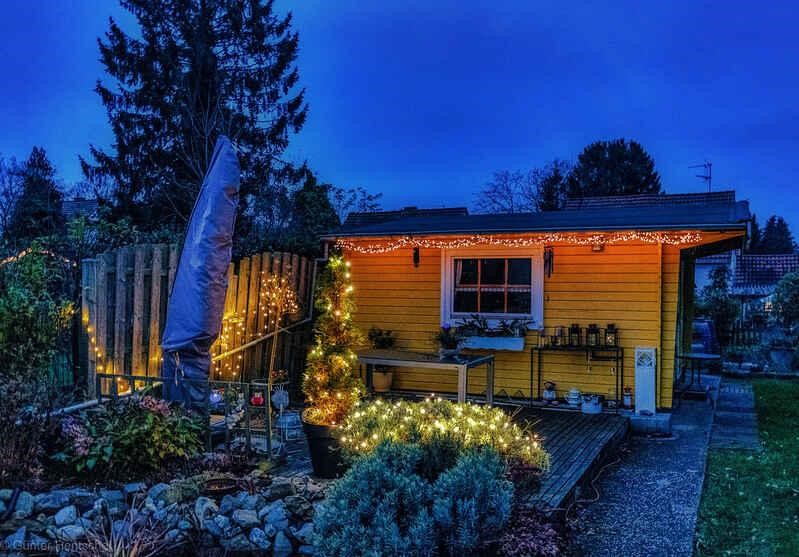
Christmas lights aren’t just for Christmas anymore! Color the backyard with strings of LED lights that sparkle throughout pergolas, tree canopies, gazebos, and patio umbrellas.
Choose from just about anything you can think of … be quirky and express your personality with festive holiday themes, hobbies, or even sports teams — we have plenty to choose from here with the Mariners, Seahawks, Sounders, Supersonics, and Kraken. Many of these LED string lights can change color with the click of a button on a remote or an app on your phone.
Festive lighting might include fairy lights in many colors, Japanese lanterns, globes, ornaments, fake candles, and light-infused decorations.
Smarten Up!
Most up-to-date low-voltage LED lighting systems rely on “astronomical timers.” Wired into “smart transformers,” like those available from FX Luminaire, these timers connect to the internet to gauge the time of sunset. That way, you don’t need a physical photocell to turn the system on at varying times as the nights get longer or shorter over the course of a year.
Most people set a specific time for the lights to turn off, such as at your bedtime.
With the right transformer/phone connection, you can even get smart by downloading an app that allows your cell phone to adjust everything with a touch of the screen.
Voice control systems using platforms like Amazon Alexa, Apple’s Siri, or Google Assistant control lights with your own commands.
Smart lighting lets you schedule garden lights from a smartphone or tablet. Color-changing lights are a fun way to enhance your mood and outdoor gatherings.
Landscape Lighting Care
When landscape lights go out, replace the bulbs. Even solar lights may need to be replaced in time, too. And when you’ve had your landscape lights for a few years, check them for cracks or loose fittings that can let in water. Why? One way to get rid of mosquitoes is to get rid of standing water anywhere in your yard – including inside your landscape lights.
DIY or Hire a Landscape Lighting Professional?
Hanging a few light strands here and there is something you can do yourself — if you have a steady ladder and are not afraid of heights. It’s easy to put solar sticks in the ground and set up a decorative outdoor ground lighting display. But crafting light displays, angling the beams, installing any kind of wiring, and setting up motion detectors should always be done by a professional. Do it right, hire a landscape architect.

Teri Silver is a journalist and outdoor enthusiast. She and her husband live on 5 acres with a vast lawn, three gardens, a farm, a pond, many trees, and a lot of yard work! The best parts of the year are summer and fall when home-grown veggies are on the dinner table.
A Satellite Dish Gazebo
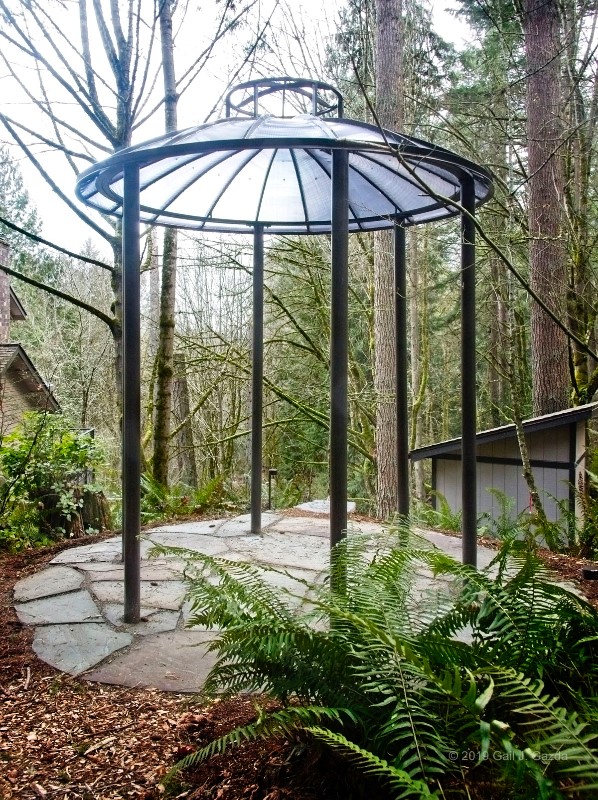
In 2016, Seattle landscape architect Brooks Kolb had the opportunity to design a large garden on a beautiful, 5-acre wooded property in Redmond, Washington. Out in the woodland surrounding the house, Brooks came upon an old satellite dish. Long disused, it reminded him of an ancient technological artifact similar to the mysterious ones that often appeared in the science-fiction TV series, “Lost.” Admiring its umbrella-like form, Brooks suggested turning it into a gazebo, and to his delight, his client agreed. Together, they decided to relocate it to an upland site above the approach drive, which they quickly dubbed “Gazebo Hill.” To turn the dish into a gazebo, it was necessary to invert it and then for it to ‘grow legs,’ which became narrow, round steel posts. To provide rain protection, they covered the steel mesh between the ribs of the umbrella top with translucent polycarbonate panels. When finished, the gazebo assumed the form of a flying saucer recently landed in Redmond, another vignette that would not have been out of place in a “Lost” episode. There you have it, a garden “folly” with a modern twist!
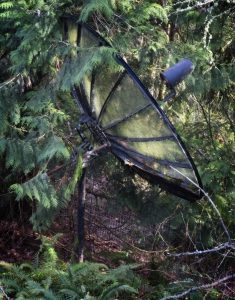
The satellite dish as first “discovered”
 The finished gazebo
The finished gazebo
A Beginner’s Guide to Growing a Bountiful Garden
A Beginner’s Guide to Growing a Bountiful Garden

Photo via Pixabay
By Carrie Spencer for Seattle Landscape Architect Brooks Kolb
Want to start a garden? Planting a garden is a wonderful way to spend more time outside, enjoy some good exercise, and have access to healthful food right in your backyard. But if you’ve never grown a garden before, it can be difficult to know where to start. From choosing the right plants to keeping weeds and pests at bay, there are several tips and tricks that experienced gardeners use to ensure a bountiful harvest at the end of every growing season. Keep on reading to learn how you can earn your own green thumb!
Start with Raised Beds
As opposed to planting straight in the ground, gardening in raised beds is a lot more manageable for beginners. This is also a great way to optimize your use of garden space. According to Savvy Gardening, raised beds prevent soil compaction and provide good drainage, so your plants will be less susceptible to root suffocation and rot. Not only that, but raised beds may deter pests like slugs and snails, which can eat up your adorable sprouts before they even get a chance. Finally, raised beds offer a more ergonomic gardening option to reduce strain on your back and neck.
Know Your “Sunset” Zone
You might already have an idea of the kinds of vegetables you would like to grow in your garden, but don’t go buy seeds just yet! It’s important to be aware of our growing season in the Pacific Northwest. The U.S. Department of Agriculture (USDA) has developed a numbered system to divide the country into frost-hardiness zones based on climate, but Sunset Magazine offers a more finely-calibrated zone chart for our region. Seattle, Mercer Island, Bellevue, and the Puget Sound lowlands are in Sunset Zone 5, whereas the Cascade foothills are in Zone 4. Determine your zone and be sure to read your seed packet labels to check when it’s best to plant to ensure a good crop. Working with plants that will thrive in your climate zone will be much easier than fighting against an early frost or high summer temperatures.
Learn About Companion Planting
The easiest way to grow a garden is to let your garden take care of itself. Select plants that like to grow next to each other—they will provide a natural source of nutrients, shade, and pest-control. As The Old Farmer’s Almanac explains, three common plants to grow together are corn, pole beans, and squash. The squash provides ground cover to reduce moisture loss and weed growth, the corn provides climbing support for the beans, and the beans help make nitrogen available in the soil for the other plants. Some other great companion plant combinations include radishes and carrots, tomatoes and basil, and lettuce and garlic.
Fertilize Your Garden
Just like us, plants need food. Fertilizing your garden properly will play an important role in its success, so spend some time learning the ins and outs of fertilization. In short, you want to provide your plants with three primary elements—nitrogen, phosphorus, and potassium. Providing these nutrients will help your garden flourish! However, you also have to be careful to avoid overfertilizing your plants, which can damage or even kill them. To find out exactly how much fertilizer to feed your garden, bring a sample of your soil to a testing lab and have it analyzed before amending it with any added nutrients.
Enjoy Your Harvest!
One of the largest benefits of growing your garden is having all of that veggie goodness right at your fingertips. To make the most of your backyard bounty, find recipes that showcase the flavors of your homegrown vegetables. For your tomatoes, consider an heirloom tomato seafood platter or make your own sauce. Whip up a homemade pesto with all of that beautiful basil or use it to add flavor to your weeknight dishes. The opportunities for healthful and delicious meals are truly endless!
Gardening might seem like a lot of work, but it’s a worthwhile hobby that just keeps on giving. Once you get started, you’ll quickly find that digging around in the dirt, pulling weeds, and watering your sprouts is an incredibly therapeutic activity. You’ll always be looking for new ways to expand your backyard plot, so get outside in the fresh air and get your garden started today!
Ask for Help
If you’re feeling overwhelmed and unsure of how to get started, consider working with a professional landscape architect to help you out. Brooks Kolb LLC can guide you through the process of designing the perfect garden. All key elements will be addressed, from construction materials to the plants you want to grow.
Seattle Landscape Architect Brooks Kolb can help you create the perfect garden that seamlessly blends form and function. Contact us at (206) 324-0858 for a free initial consultation!
 Garden writer Carrie Spencer can be reached at carrie@thespencersadventures.net.
Garden writer Carrie Spencer can be reached at carrie@thespencersadventures.net.
Five Popular Outdoor Renovations That’ll Add Value to Your Seattle Area Home
By Evette Zalvino, Freelance Writer for HomeLight, for Seattle Landscape Architect Brooks Kolb
Top Agent Insights for Spring 2021: Seller’s Market Sizzles Across U.S. (homelight.com)
Renovating your backyard is a great way to prepare for a summer of entertainment, and these five renovations will add a lot of value to your Seattle home.
2020 was one heck of a year, wasn’t it? Now that 76% of Seattleites are fully vaccinated for COVID-19, it’s time to make plans to invite guests over for barbecues, parties, and a good ole’ game of volleyball (or whatever your family and friends like to play). It’s also the perfect time to give your backyard a complete overhaul and turn it into a fun and beautiful oasis that everyone will want to use and enjoy.
The question is, where do you even start; or if you’re looking to sell your home, which projects will add the most value to your home? After gathering some insights from real estate agents and landscape architects in Seattle, these landscaping renovations are what many homeowners want the most:
1. Outdoor living space
Homeowners are treating their backyards as an extension of their homes, so it shouldn’t be much of a surprise that nearly every homeowner wants an outdoor living space. This renovation isn’t just popular in Seattle, 52.5% of surveyed real estate agents from all over the country report clients say this is on their “wants” list.
These outdoor spaces can be as elaborate as you’d like, but many people opt for a simple seating terrace, with a separate dining area. It’s important to note that these spaces are not just relegated to the backyard – you can create a beautiful (but private) front garden where you can relax and enjoy a cup of coffee.
2. Lawns for playing
If you have young children (or you’re a child at heart), having a luscious lawn that’s large enough for playing outside is important for at least 50% of residential landscape clients, and can go as high as 100% for people with young children). The best types of grass for the Seattle area include Fescue and Ryegrass. These varieties are extremely resilient and, the right soils, sun exposure, watering, and regular mowing program, can withstand rigorous game-playing.
Having a large grassy area for games doesn’t mean that the rest of the landscaping must be boring or drab. You can use hardscaping to create a path that separates the lawn from garden beds filled with your favorite perennials, annuals, and shrubs.
3. Outdoor grilling setup
You may have a charcoal grill that’s seen better days, so why not plan a renovation suited for the grill master that you are? An outdoor grilling station will give you a place where you can whip up delicious barbecue while entertaining your guests – after all, who wants to be left out of all the juicy gossip or life updates?
There are a variety of options when it comes to creating the ideal grilling station that suits your needs. Many if not most people prefer to keep it simple, locating their grills on the edge of a patio, against a wall. However, you could consider erecting a pergola over your grill for rain protection, or you could install a built-in brick, wood or stone grilling station with a countertop for food preparation. There are a lot of possibilities to tailor the set-up for your particular needs.
4. Outdoor fire feature
While everyone calls them fire pits, “fire feature” is a more accurate term to describe all the various design options available to people who want to enjoy the heat and light that an outdoor fire can provide. Seattle landscape architect Brooks Kolb reports that at least 35% of his clients request a custom fire feature, while nationally 76.8% of real estate agents represent clients who either have or want fire pits. A fire feature is a great place to relax on the cooler nights while enjoying your garden or chatting with friends and family.
One affordable solution is to purchase a catalog-order fire table, which can double as an outdoor coffee table for your conversational setting, but if budget permits, custom-built fire features can incorporate masonry that matches or compliments your home’s architectural design.
5. Raised garden beds
There’s nothing like fresh herbs and vegetables to take your cooking up to a whole new level. However, bending over to tend to the plants or harvest them can be difficult for some homeowners. To remedy this or to provide an easy way to cut flowers for indoor bouquets, many people ask for raised garden beds to be a primary feature of their new landscape design. Moreover, if your garden has heavy clay soils, raised beds are almost a necessity, as they facilitate bringing in a loamy topsoil.
Whether you want to spend more time in your garden, you’re looking forward to entertain guests outdoors, or you just want to boost your property value, these landscaping renovations are a great way to start. With a little bit of imagination and planning, your landscaping is sure to be the talk of the town!
If you’d like more specific suggestions or recommendations on all these garden design features, please contact Seattle landscape architect Brooks Kolb, at 206-342-0858.
Creating Curb Appeal for House Sale
by Clara Beaufort, for Seattle Landscape Architect Brooks Kolb. Clara is a garden writer and community gardener based in Georgia. She created GardenerGigs to connect local gardeners with those in need of plant care help. You can reach her at clara@gardenergigs.com.
Any good real estate agent will tell you that creating curb appeal is an essential step when you plan on putting your home on the market. Your home’s interior could be completely remodeled with all the best upgrades, but if the exterior is lackluster, many buyers won’t even walk through the door. The good news is that investing in curb appeal does more than just help sell your house faster. It also improves your home’s value, so you can be confident that it’s money well spent.

Brooks Kolb’s Design for a Laurelhurst Front Living Room
Lawn and Garden 101
When you’re ready to invest in improved curb appeal, the hardest part for most homeowners is figuring out what to do first. Think of this step as Lawn and Garden 101 – you’re getting a feel for what it takes to get your yard in tip top shape. The first tasks to do will vary by season, so we suggest starting with a seasonal checklist. For example, Martha Stewart’s spring gardening tips include surveying your yard first, then deciding how to fill any gaps, reseeding grass, pruning, and preparing flower beds.
Starting with these tips will help you come up with a lawn and garden plan, plus it will help ensure you’re choosing the right plants for the season. Timing and choosing plants carefully is always important with landscaping, but especially when you want to sell your house. This is because plants that are in bloom and have lots of color will make the biggest impact on buyers. To get this maximum effect, The Spruce recommends that spring sellers plant early bloomers, hardy annuals, and flowering shrubs.
Creating and maintaining a beautiful lawn and garden is a lot of work, but you don’t have to do it all on your own. Whether you don’t have a green thumb or you simply don’t have the time it takes, hiring a gardening service is an easy way to get (and keep) the results you’re looking for. These pros specialize in all aspects of landscaping, whether you need help with the planning stage, planting, weeding, or other maintenance needs. And, remember, spring is the ideal time to make your exterior shine.
Tackle Other Exterior Projects
Curb appeal is about more than just your lawn and garden, which is why the next item on your to-do list should be addressing other exterior issues. This includes fixing anything that’s broken or worn looking, plus making cosmetic improvements strategically. Look at things like making repairs, such as fixing a broken deck board, along with cleaning spots you wouldn’t normally think about, such as your home’s roof and siding.
Inexpensive Extras
In addition to doing the necessary work of repairs and cleaning, buyers will be even more impressed if you go the extra mile with curb appeal. This doesn’t mean you have to spend a fortune or a ton of time. Our suggestion is to pick just a few “extra” projects that will make the biggest impact, such as creating a more welcoming front entryway.
If your front door is looking shabby, give it a fresh coat of paint, and don’t forget about house trim and shutters. Along with a spruced up front door, make your front porch even more inviting with a container garden, adding a seasonal wreath, and a new welcome mat.
It’s also smart to think about making the most of your home’s outdoor spaces for the season you’re in. If you’re selling in spring, a birdhouse is a great seasonal accent for your garden, and the beautiful birds you attract are an added bonus. Or if you’re selling in summer, consider staging outdoor spaces to highlight the potential for backyard barbeques.
When you’re getting your home ready to sell, you want to highlight its best features while making house hunters feel welcome. Don’t underestimate the value of curb appeal, which affects your home’s appraisal value, to give that warm impression! From a neat and tidy lawn to seasonal accents, every improvement you make outside will help get buyers through the door – AND a better price at closing.
Recent Work: A Cascadia Avenue Garden
Seattle Landscape Architect Brooks Kolb is proud to announce the completion of an extensive new garden on Cascadia Avenue in the Mount Baker garden. The front garden features six rectangular perennial beds flanking the central front walk, while the much larger back garden boasts a substantial number of amenities: a swimming pool, shed with kitchenette, sports court and children’s play area. A raised hot tub is situated to look out over the flames of a custom, natural gas-fed fire feature to views of Lake Washington beyond. In addition, a custom tree house nestles in an Evergreen Magnolia tree for the owner’s young children. More than thirteen varieties of fruiting trees, shrubs, vines and espaliers are distributed throughout the garden, all without blocking views of the lake. Brooks collaborated with architect Kim Lavacot for the shed and tree house.
Photographs by Miranda Estes Photography
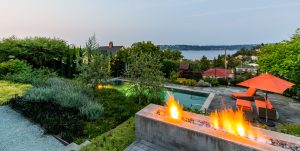
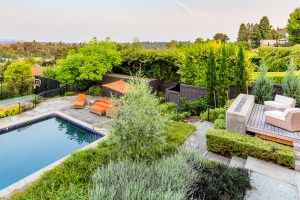
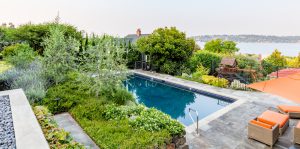
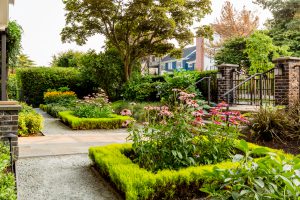
Recent Work: A Mount Baker Garden
Seattle Landscape Architect Brooks Kolb is proud to announce the completion of a substantial new hillside garden in the Mount Baker Garden. Since the main floor of the house is at a much lower elevation than the street, an elegant concrete stair winds down past a dramatic waterfall to the front door. From the main stair landing, a wide gravel path loops around to the back garden, which features a tranquil koi pond and a mahogany observation deck with sweeping views of Lake Washington and the Cascades. On the north side of the house, a second stair descends to a lower level rental unit which has its own lawn. Lush plantings of trees, shrubs, ornamental grasses and perennials are distributed throughout the garden, while a variety of erosion control shrubs anchor the steep slope below the deck. Brooks collaborated with Turnstone Construction on the two contrasting water features.
Photographs by Miranda Estes Photography
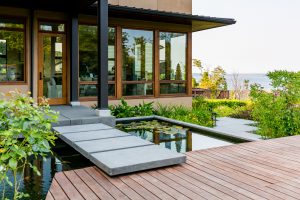
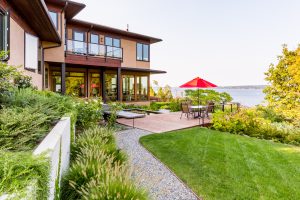
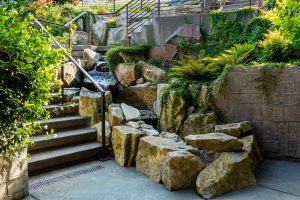
Brooks Kolb’s dad Keith Kolb honored by UW

Seattle Landscape Architect Brooks Kolb’s father, Keith Kolb, FAIA, was honored last Saturday night in the Alumni Awards Program of the University of Washington’s College of the Built Environment (UW CBE.) My 95-year old dad was honored as a distinguished Professor Emeritus for his outstanding record of teaching architecture until his retirement at age 70. The program included 3 awards given to recent graduates, plus 2 “Distinguished Alumni Awards.” These last went to Lee Copeland, FAIA, who was Dean at the University of Pennsylvania’s Graduate School of Fine Arts (now re-named Graduate School of Design) when I was in the master’s program there, and Steven Holl, the New York-based architect who designed the beautiful Chapel of St. Ignatius on the Seattle University Campus as well as the Bellevue Arts Museum.
Here are 2 photos of dad, dated April 1, 2017, with (from left to right) Marga Rose Hancock, the long-time Executive Director of the Seattle American Institute of Architects (AIA); Betty Wagner, the long-time UW Architectural Librarian; and Jane Hastings, an architect colleague of dad’s who broke the (lower) glass ceiling in the 1950’s by receiving her degree in architecture and going on to a successful architectural practice in Seattle.


Hellebores – Harbingers of Spring in the Pacific Northwest
by Seattle Landscape Architect Brooks Kolb
It’s been an especially wet and cold winter in the Pacific Northwest, but we’re finally beginning to see the first signs of spring. Winter-blooming Witch Hazels and Camellias have already finished flowering, and now is the time for Hellebores to take center stage. No Hellebore species is more popular than Helleborus orientalis. Known as “Lenten Rose” for the time of its bloom period, this Hellebore has already been blooming for several weeks and it should continue through at least the end of March. Depending on the exact variety, its pale flowers on narrow, foot-high stems in shades of pink, purple, magenta, cream and chartreuse look like they were painted in watercolor washes. It’s nice to plant massings of all-white varieties, but deep pink ones like ‘Pink Frost’ are also attractive. It’s easy to find them in batches of mixed hybrids if you want random samplings of the entire color range in a single planting bed.
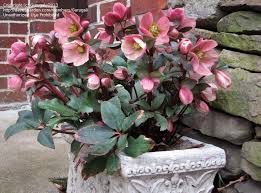
Helleborus orientalis ‘Pink Frost’
Among the other species, Helleborus niger (“Christmas Rose”) looks very similar to Lenten Rose except that its leaves have no obvious stems, while H foetidus (“Bears’s Foot hellebore) has strikingly narrow leaves. But, apart from Lenten Rose, the other species I like to use in my designs is the Corsican Hellebore (H. argutifolius.) This one is much taller and wider, to about 3 feet tall and 3 feet wide, with tough, leathery mint-green leaves and large, showy chartreuse flowers that bloom in February and hold their blooms until you finally decide to cut them off in early summer. The Corsican Hellebore is a great ornamental evergreen shrub for partly shaded spots in the garden and is a good selection for the back or middle of a garden bed, with the lower Lenten Roses occupying spots below it in the foreground.
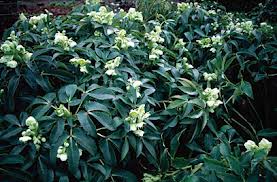
Helleborus argutifolius
Great Plant Picks for Winter
Snowberry – Symphoricarpos albus
Arnold Promise Witch Hazel – Hamamelis x intermedia ‘Arnold Promise’
Star Magnolia – Magnolia stellata
I always tell my clients that a Seattle garden should be designed with winter in mind. If a garden looks good in winter, it’s almost guaranteed that it will look really great in spring and summer. Above are three great plant picks that are are certain to lift your spirits in winter: Snowberry, with its white berries on bare winter twigs; Arnold Promise Witch Hazel, with confetti-like yellow flowers in January, and Star Magnolia. The photo shows Star magnolia blooming in the spring, but in the winter, its fuzzy, pussy-willow-like buds are a lovely promise of spring to come. The larger Saucer Magnolia (Magnolia soulangiana) has equally gorgeous winter buds.


